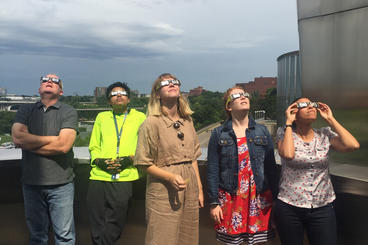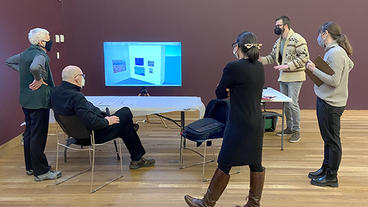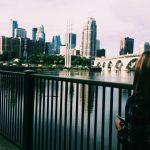FEATURED ESSAY
For their final program of the semester, the Weisman Art Museum’s student group, WAM Collective, convened a virtual roundtable with peer student advisory groups, the Student Advisory Council at the Tang Museum at Skidmore College, and the Agents for Creative Action (ACA) of the Williams College Museum of Art (WCMA). On the afternoon of May 5, 2021, each group presented their vision for the future of the museum field to an audience of museum professionals, leaders, and enthusiasts.
Over the past year, the museum field has reckoned with major societal challenges: the COVID-19 pandemic and its fallout; the ongoing civil rights movement for racial justice in the United States; and renewed calls for repatriation of art and cultural materials—to name just a few. With this reality in mind, these emerging museum practitioners were asked to engage in an intellectual exercise and to chart a path for a new kind of museum.
Watch the full, closed captioned event recording on the Weisman's YouTube channel. Key threads that emerged during the discussion are synthesized in a written summary below.
What is the role of museums today? What needs to change? How can we create it together?
Museums should radically transform power dynamics
All three student groups described the role of museums, historically, as gatekeepers of knowledge and history in one way or another—a contention that brings forth a number of questions: Who, exactly, gets to engage in knowledge-making in museums? Whose history is presented? How do we deal with the “cult of the curator”? While art museums today have worked to expand the art historical canon through scholarship, exhibitions, and accessions, there is still much work to be done.
The future of museums, according to the student presenters, is polyphonic, or multivoiced, with democratized and decentralized modes of operation. In the futures they envision, power is flat, rather than hierarchical. This shift would require restructuring museum labor, rethinking who produces knowledge, and reimagining curatorial departments, which have long been regarded as the intellectual hub of the museum.
In preparation for the student roundtable, Calen Gwiser-Cseh, a member of the WCMA Agents for Creative Action, browsed the web for graphics of museums and noted an abundance of stereotypical clip art—neoclassical buildings with massive white pillars. They pointed out how this archetype functions metaphorically as a “temple of whiteness,” with the pillars literally “upholding colonial beliefs and practices of exoticizing and extracting culture from people.” WAM Collective Officer Isabella Gold explained that in order to diversify the museum field, new access points are necessary, requiring museums to accommodate other forms of knowledge, outside of the Western academic mode in which curators usually operate.
How do we make room for more voices? Students from all three groups urged university museums to trust students and community members to tell their own stories. Maria Staack, a member of the Student Advisory Council at the Tang, pointed to the work that the Tang is already doing, citing a recent exhibition by Skidmore student Malchijah Hoskins, who chose to display his du-rag in the Hyde Cabinet, a student-curated space at the museum. WAM Collective Officer Lauren Borchart proposed that more exhibit development and storytelling be done through guest curatorships filled by community members. Another way to shift the power dynamics would be to allow students to pitch artworks for the permanent collection, which was the focus of a class in which WCMA ACA student Victoria Liu was enrolled.
Museums should center human experiences, and focus less on objects
Decolonizing the museum and dismantling “temples of whiteness” means more than diversifying museum staff and giving voice to underrepresented communities. Those are important steps for the future of museums, certainly, but arguably equally important is reconciliation for past wrongdoings. Students from both the Weisman Art Museum and Williams College Museum of Art discussed their own institutions’ ongoing experiences with repatriation and deaccessioning, respectively.
In her presentation, WAM Collective Officer Isabella Gold wondered aloud, “But what does it really mean to decolonize a museum? Can museums truly be decolonized? Audre Lorde writes ‘the master's tools will never dismantle the master's house.’ Museums are organizations that operate through colonial systems that order, and name, and number, and categorize. It's hard to believe that such a big ship can be turned at the speed necessary.”
This colonial process of ordering and categorization, and the Western fetishization of ‘art’ objects, often divorces cultural material from the context in which it was produced. Recovering those stories, mining collections and archives for new perspectives, is important work for the future of the museums. For her capstone project as the Meg Reitman Jacobs Intern at the Tang, Maria Staack proposes that a way to tell new stories is by cataloging artists’ identities. While working on an exhibition centered on Black abstract art, Staack requested a list of applicable works in the Tang's collection. She received a list, but it was generated through recollection by staff, rather than pulled from a database. Through this list, fortunately, Staack encountered a rarely-exhibited painting by William Villalongo, titled Funky Space Reincarnation, but she wonders how many abstract works by Black artists go unrecognized or forgotten altogether in museum collections. She shared that, “If we were to catalog artists’ identities, museums can begin to display a wider range of art by underrepresented groups because their identities will not necessarily have to be so blatantly represented in the visuals of the artwork.”
Victoria Liu of the WCMA ACA proposed that the future museums will “use art as a way to really anchor our community. The future museum structure can actually be inherently supportive of new and untold stories rather than just holding objects. And so, from a collection of objects and cultural properties, we can become a collection of community connections.”
Museums should be physically, intellectually, emotionally, and economically accessible to all
In order to build a “collection of community connections”, as WCMA put it, museums need to prioritize accessibility broadly.
In their vision for the future of museums, WAM Collective believes that museums should be physically and intellectually accessible to all and affordable, or free of charge. WAM Collective Officer Sage Caballero spoke about the importance of accessibility as a consideration in every aspect of museum operations, rather than being treated as solely the responsibility of education departments (which is all too often the case.) Sage elaborated that, “We want to think about disability as a methodology, to cultivate these new spaces that are accessible and able to be experienced by everyone regardless of disability” and shared how the Weisman is beginning this work in earnest, thanks to an IMLS grant-funded initiative.
Evan Little of the Tang’s Student Advisory Council proposes that digital accessibility of museum collections will further democratize knowledge-making, opening up space for new stories to emerge. Little asserted that the future of museums will be “a time where digital access and creation of digital exhibitions are normal, where access to images and information on objects is shared widely—where exchange is celebrated and connections are easier to make.”
Ethan Richmond of the WCMA ACA stressed, museum accessibility begins with the museum space itself, arguing that human comfort and experience needs to be considered in design just as much as the art. He explained that museums nowadays are hyper-aestheticized, noting that their spaces are overwhelmingly white, both racially and spatially, (e.g. “white cube” gallery spaces). Richmond explained that, “for people of color, or those not familiar with what a museum is supposed to be like and how to act in one, museums feel too sanitary—like you can't touch anything or comfortably inhabit your own body in the space.” Furthermore, he noted, “even if we make all museums free and accessible, this question of social, relational, and bodily comfort still remains. There is work to be done to dismantle the whiteness sewn into museum culture and rebuild the idea of who museums really belong to.”
Museums should be a flexible, fluid, and dynamic spaces for community engagement
In making museums more accessible and welcoming for all, community-building and engagement can flourish. Richmond went on to say that, in serving underrepresented and marginalized communities, museums can begin to shift the power dynamic and give the public a greater sense of ownership over the space.
WAM Collective Officer Özge Ahunbay noted that Collective hopes to “look towards a future where museums are a dynamic space for self-reflection, personal growth, and community engagement.” Along the same lines, the ACA students at WCMA stressed that museums should demonstrate a high degree of openness to change.
The student groups all pondered the limits of the museum space, envisioning a future where museums could sometimes take shape as nonphysical, porous spaces. The WAM Collective cited Seattle’s Wa Na Wari as an example of such a space, as well as the work of the Weisman’s Target Studio for Creative Collaboration.
So, what does the museum of the future look like? WAM Collective’s vision, presented by Özge Ahunbay, is as follows: “We decided it should be somewhere to display dynamic and diverse forms of art, relay knowledge about cultural or historical information, be inclusive to all types of people across differences of race, sexuality, class, and age, and also [a place to] fulfill and articulate a social responsibility. Beyond just the display of art we believe museums should host art activities that invite physical exchange that are physically and intellectually accessible and should be affordable or free of charge. With this in mind, our definition [of a museum] did not necessarily require a collection, but rather focused on the interaction between community, the self, and art.”
About the Presenters
WAM Collective, of the Weisman Art Museum at the University of Minnesota, serves as the student voice of and for the museum. WAM Collective acts as a bridge between the widely diverse student body of the University and WAM. The Collective fosters student ownership of the museum, advises staff on effective ways to engage the student body, and is proactive in promoting WAM throughout the University community and beyond. This manifests through programming, content creation, and engagement with the local arts community.
Student Participants: Özge Ahunbay, Lauren Armani, Lauren Borchart, Sage Caballero, Isabella Gold, and Amie Stager
The Student Advisory Council at The Frances Young Tang Teaching Museum and Art Gallery serves as an important voice for the Skidmore student body within the Tang Museum with the goal of fostering and strengthening the museum’s relationship with students. Members serve as representatives of the student body to the Tang staff and advise staff on its relationship with Skidmore students serve as ambassadors of the Tang’s mission, exhibitions, and programs to Skidmore students, and advocate for the museum among friends, peers, and the Skidmore community, learn about the inner workings of the museum, its staff and mission have the opportunity to develop public programs in collaboration with museum staff, Skidmore student groups, and community organization.
Student Participants: Jane Cole, Evan Little, and Maria Staack
The Agents for Creative Action (ACA) is a cohort of students who work with the Williams College Museum of Art during the school year to explore museum practice as a creative process. ACA participants animate the museum’s collections, exhibitions, and spaces through the development of original projects and programs, and contribute to museum-wide initiatives. During weekly meetings and workshops with museum staff and guests, they develop storytelling skills and exercise creative thinking and making.
Student Participants: Chris Fernald, Calen Gwiser-Cseh, Victoria Liu, Nina Pelaez, and Ethan Richmond


